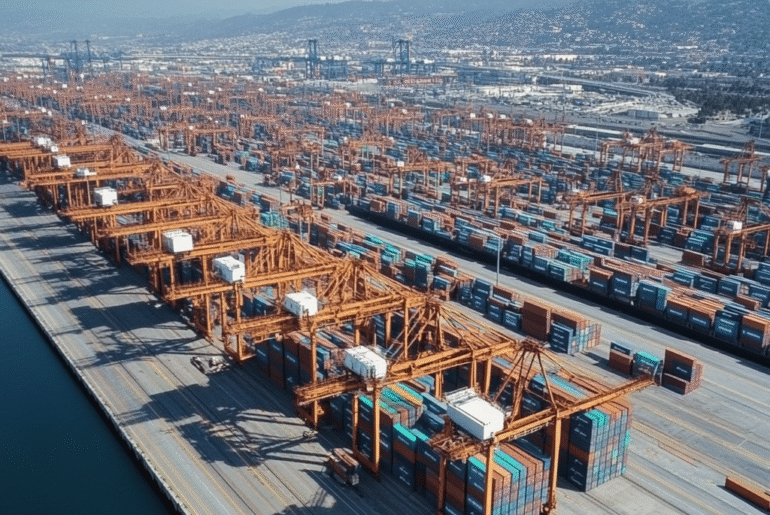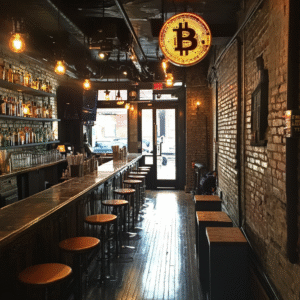This article may contain references to products or services from one or more of our advertisers or partners. We may receive compensation when you click on links to those products or services. Nonetheless, our opinions are our own.
The information presented in this article is accurate to the best of our knowledge at the time of publication. However, information is subject to change, and no guarantees are made about the continued accuracy or completeness of this content after its publication date.
The Port of Los Angeles is an important part of the American economy and a key link in the global supply chain. This shipping hub is known for its size and efficiency. It makes it easier for goods to move between the US and other countries. But starting in 2018, a huge trade war launched by the Trump administration caused major problems. Tariffs on Chinese imports changed trade, made ports less efficient, and disrupted local economies. We’ll look at how the trade war changed the Port of Los Angeles, including its operations, workers, local economy, and changing role in global trade.
- Knowing the Trade War
- The Immediate Impact on Port Operations
- Declining Trade Volumes and Shifting Routes
- Economic Ripple Effects on Local Businesses
- Parallel Challenges at the Port of Long Beach
- Adapting Through Innovation and Strategy
- Community Response to Human Impact Labor
- Opportunities and Resilience Post-Tariff
- Conclusion
- Frequently Asked Questions
- Recommended Reads
Knowing the Trade War
The U.S. government put high tariffs on hundreds of billions of dollars’ worth of goods that came from China in 2018. The goals listed were to lower the trade deficit, protect intellectual property, and change the balance of trade between countries. These rules made an already complicated global system even more unstable. Tariffs, which are basically taxes on goods coming into the country, made things more expensive for both businesses and consumers. The cost of goods like electronics and furniture went up, which made it hard for importers to make good decisions about how to handle the situation. The Port of Los Angeles, which is the main way for goods to get into the U.S. from Asia, felt the effects right away.
The Immediate Impact on Port Operations
As tariffs took effect, many importers rushed to bring in goods before higher rates were imposed. This created a temporary spike in container volumes, followed by a sharp decline once the tariffs were fully in place. Freight that once moved with predictability now arrived in erratic bursts, straining scheduling systems and labor resources. Terminal operators, logistics companies, and trucking firms faced major challenges in adapting to this inconsistent flow. Equipment utilization rates dropped, and yard congestion increased during traffic surges. For a port known for its efficiency, this stop-start rhythm undermined long-term planning and strained capacity.
Declining Trade Volumes and Shifting Routes
By the end of 2019, container volume at the Port of Los Angeles had declined by approximately 10% compared to the previous year. Many importers shifted sourcing to countries like Vietnam, Malaysia, and the Philippines to sidestep the punitive tariffs on Chinese goods. This redirection of trade disrupted established shipping routes and threatened the economic health of U.S. West Coast ports. The decline in traffic affected not just port authorities but a wide range of support services. Truck drivers, warehouse workers, and equipment operators all reported reduced work hours and diminished income opportunities.
Economic Ripple Effects on Local Businesses
The ripple effects of declining port activity were felt throughout the regional economy. Many small and mid-sized retailers relied on affordable imports to stock shelves and stay competitive. As shipping costs rose and delivery times became unpredictable, these businesses faced lower margins and increased operational risks. Unlike larger corporations, smaller firms often lacked the leverage or flexibility to renegotiate supplier contracts or reroute logistics. This left many exposed to financial strain, contributing to closures and layoffs in the local economy.
Voted "Best Overall Budgeting App" by Forbes and WSJ
Monarch Money helps you budget, track spending, set goals, and plan your financial future—all in one app.
Get 50% OFF your first year with code MONARCHVIP
Parallel Challenges at the Port of Long Beach
The Port of Long Beach, situated adjacent to the Port of Los Angeles, experienced similar disruptions. These two ports typically operate in tandem and together handle the bulk of containerized imports from Asia. When traffic slowed due to trade policy changes, Long Beach saw comparable reductions in freight volume. The economic ecosystem supporting both ports, comprising trucking companies, fueling stations, chassis yards, and third-party logistics providers, experienced immediate financial stress. Businesses that depended on steady freight movement struggled to stay afloat, compounding regional job losses.
Adapting Through Innovation and Strategy
To remain competitive amid geopolitical uncertainty, the Port of Los Angeles began implementing strategic reforms.
Investing in Technology
Port leadership prioritized digital infrastructure and automation. “Port optimization” initiatives were designed to improve cargo flow, reduce dwell times, and better allocate labor. Technologies such as predictive scheduling tools, AI-assisted logistics systems, and automated cranes were deployed to modernize outdated workflows. These innovations allowed terminal operators to handle shipments with greater efficiency, even when volumes fluctuated unpredictably.
Market Diversification
To reduce dependence on Chinese imports, the port pursued new trade relationships with emerging markets. Increased engagement with countries like Vietnam, India, and South Africa marked a strategic pivot toward diversified sourcing. These efforts aimed to cushion the port from future geopolitical or economic disruptions.
Community Response to Human Impact Labor
Port workers, longshoremen, truck drivers, and warehouse personnel bore much of the emotional and economic brunt of the trade war. Uncertainty surrounding job security became a persistent concern as container flows dried up or surged unexpectedly.
Labor Conditions and Anxiety
Workers reported inconsistent hours and diminished morale. Some experienced temporary layoffs, while others were overwhelmed during influx periods. The unpredictability of work created stress not only for individuals but also for families dependent on stable income from port-related employment.
Community and Union Support
Labor unions and nonprofit organizations responded by offering support services, advocating for job protections, and lobbying for long-term economic development in the region. These initiatives emphasized workforce retraining, healthcare access, and career resilience programs, aiming to protect workers from ongoing volatility.
Opportunities and Resilience Post-Tariff
As the initial phase of the trade war receded, the Port of Los Angeles entered a recovery and adaptation phase. Though global trade tensions persist, the port has positioned itself to better handle instability.
Infrastructure Expansion
Major capital projects are underway to expand terminal capacity, improve rail connectivity, and strengthen cybersecurity. These investments reflect a long-term vision for maintaining competitiveness in a more fragmented and unpredictable trade environment.
Sustainability and Environmental Goals
The port is also moving aggressively toward environmental sustainability. Initiatives include electrified cargo handling equipment, zero-emission trucks, and green energy-powered infrastructure. These programs not only reduce environmental impact but also align with global shipping standards and regulatory pressures.
Conclusion
The trade war between the U.S. and China changed the course of the Port of Los Angeles. The port used to be a symbol of smooth global trade, but now it is going through a rough patch with falling trade volumes, worried workers, and a strained economy. But the response, which was based on innovation, diversification, and resilience, shows how flexible the port is. The Port of Los Angeles is not only an important logistics center today, but it is also a good example of how to deal with systemic disruption. As international trade changes, this famous port will probably stay at the top, teaching us how to adapt our strategies, change our technology, and stay strong in the face of economic challenges.
Frequently Asked Questions
What triggered the U.S.-China trade war?
The trade war began in 2018 when the Trump administration imposed tariffs on Chinese goods in an effort to reduce the U.S. trade deficit and address concerns over intellectual property theft and unfair trade practices.
How did the trade war affect the Port of Los Angeles?
The port experienced fluctuating container volumes, operational bottlenecks, and financial pressure. Importers scrambled to ship goods before tariffs increased, causing temporary spikes followed by prolonged declines in traffic.
Were local businesses affected?
Yes. Local businesses that relied on imports faced supply shortages, increased costs, and declining revenue. Many small retailers lacked the resources to adapt quickly, leading to layoffs and closures.
How did workers respond to the changes?
Port workers faced uncertainty about job stability, with inconsistent work hours and reduced morale. Unions and community groups provided support through retraining programs and job protection advocacy.
What changes were made to help the port adapt?
The Port of Los Angeles invested in advanced logistics technologies, pursued trade relationships with new countries, and launched environmental sustainability initiatives. These changes aim to create a more flexible and future-ready infrastructure.
What is the future outlook for the port?
The outlook is cautiously optimistic. With improved infrastructure, diversified trade partnerships, and a commitment to innovation, the port is better positioned to weather future disruptions and maintain its role as a key player in global shipping.

Reviewed and edited by Albert Fang.
See a typo or want to suggest an edit/revision to the content? Use the contact us form to provide feedback.
At FangWallet, we value editorial integrity and open collaboration in curating quality content for readers to enjoy. Much appreciated for the assist.
Did you like our article and find it insightful? We encourage sharing the article link with family and friends to benefit as well - better yet, sharing on social media. Thank you for the support! 🍉
Article Title: How Trump’s Trade War Has Whipsawed the Port of L.A.
https://fangwallet.com/2025/06/28/how-trumps-trade-war-has-whipsawed-the-port-of-l-a/The FangWallet Promise
FangWallet is an editorially independent resource - founded on breaking down challenging financial concepts for anyone to understand since 2014. While we adhere to editorial integrity, note that this post may contain references to products from our partners.
The FangWallet promise is always to have your best interest in mind and be transparent and honest about the financial picture.
Become an Insider

Subscribe to get a free daily budget planner printable to help get your money on track!
Make passive money the right way. No spam.
Editorial Disclaimer: The editorial content on this page is not provided by any of the companies mentioned. The opinions expressed here are the author's alone.
The content of this website is for informational purposes only and does not represent investment advice, or an offer or solicitation to buy or sell any security, investment, or product. Investors are encouraged to do their own due diligence, and, if necessary, consult professional advising before making any investment decisions. Investing involves a high degree of risk, and financial losses may occur including the potential loss of principal.
Source Citation References:
+ Inspo
California State Senate. (2025, February 4). SB 263 (Gonzalez): PRICE Act – Preventing Risk of Income Collapse and Economic harm.












































